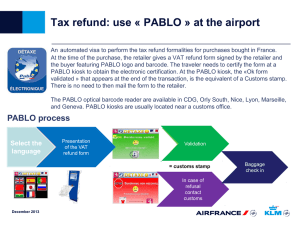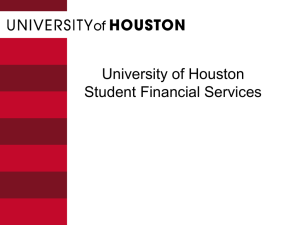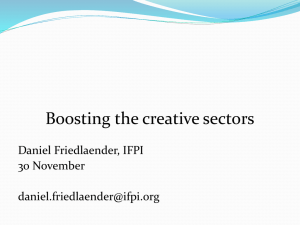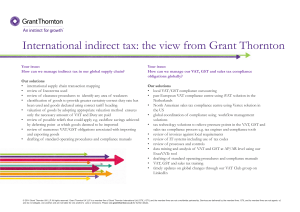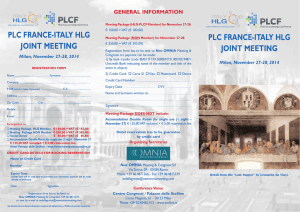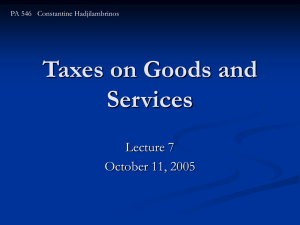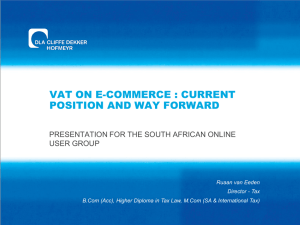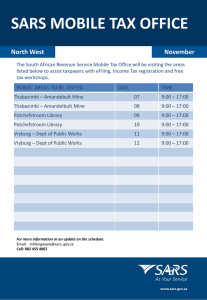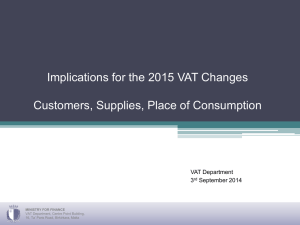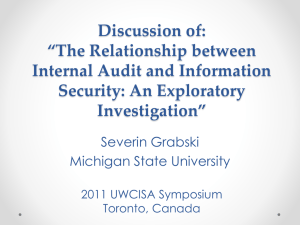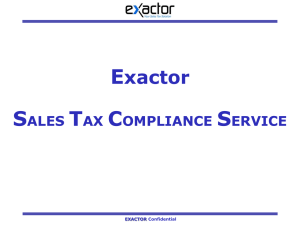Document
advertisement
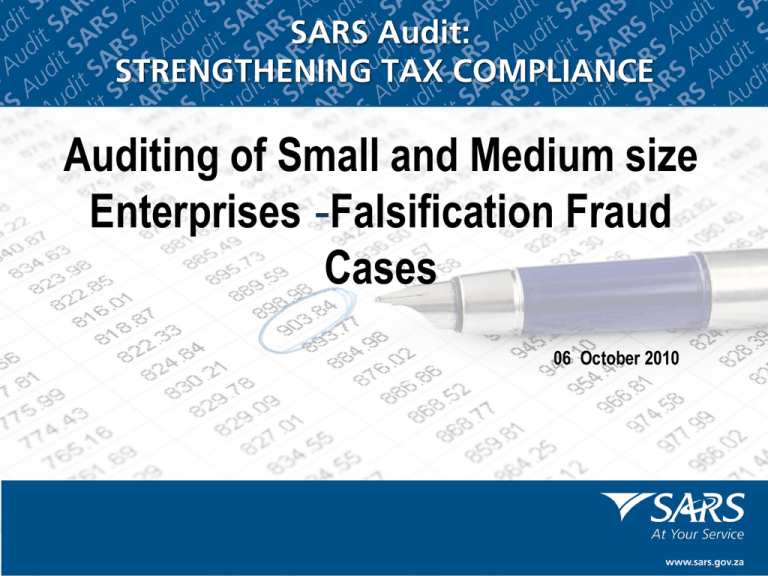
Auditing of Small and Medium size Enterprises -Falsification Fraud Cases 06 October 2010 Contents Background Compliance Value Added Tax (VAT) Personal Income Tax ( PIT) Company Income Tax (CIT) Challenges SARS Approach Case Studies 2 Background Auditing of SMEs and specifically of falsification and Fraud cases is but one of audit categories that is conducted by SARS Audit as part of investigative audits. Other categories are Random Refund Inspection Audits The Diagram below will illustrate where this type of auditing fits as part of the bigger auditing frame work Investigations Escalations Compliance risk Hot line Enforcement Investigations Conviction Prosecution Media leverage Criminal Illicit Improved compliance (incl. Customs) Audit Escalation from small e Compliance risk Administrative resources Refunds (Nat61) Enforcement Audit Low volumes High impact High skill Risk based High ROI Investigative: Assurance Generic risk Specific risk Specialised Audits (incl. LBC Audit Customs) Improved compliance Deregistration Risk engines Small e Case Generation + + Research +Walk ins + Media + Analysis + Surveys + Focus Groups Informants SAR’s + Research and Segmentation Enforcement Program + SARS Audit Architecture High volumes Productionised Administrative compliance Light intervention Low ROI BEADS Inspections Correspondence Telephone audits Low risk refunds (Compliance centres) Customs (PCI inspections) Campaigns Background Cont. SARS IT systems are currently not integrated and work independently from each other i.e. Value Added Tax Income Tax Employees Tax Refund is one of the risks that triggers audits in all tax types In all the tax types falsification happens at the following stages Registration Declaration Refund Payment A refund value threshold system is one of the risk rules used to identify cases for auditing intervention before a refund is paid out Cross Tax Registrations - Summary 740,000 IT REGISTERED PAYE REGISTERED SDL REGISTERED NOT IT REGISTERED NOT PAYE REGISTERED NOT SDL REGISTERED 19% 2% 81% 24% UIF REGISTERED NOT UIF REGISTERED 27% 20,000 Total VAT Vendors Sanitation Investigation 98% COMPANY/CC 76% ESTATE/TRUST 73% INDIVIDUALS Discussion: • Of the estimated 740” VAT vendors on register, 20” VAT vendor cases were investigated as part of the WHOLESALE AND RETAIL TRADE; VAT Register Sanitation initiative REPAIR OF MOTOR VEHICLES, • The majority of vendors are of Companies/CC’s, followed by Individuals and Estates/Trusts MOTOR CYCLES AND PERSONAL AND • From an economic perspective, these vendors fall mostly in the Financial Intermediation, Insure, Real Estate and Business Services.HOUSEHOLD GOODS; HOTELS AND RESTAURANTS • With a few exceptions (probably data quality related), all cases have valid Income Tax registrations • 76% of the cases are not registered for PAYE yet most cases are Companies/CC’s within industries that should show PAYE behaviour • Similar to PAYE behaviour, the SDL and UIF registrations for these vendors are also suspiciously low 6 REFUND VALUES* REFUND CASES 2004 – 2010: R0.034 Billion 2008 - 2010: R0.019 Billion 15% R10,836 Billion R2,671 Billion R1,414 Billion R4,566 Billion 9% 15% 8% 21% 11% 25% 11% 12% 18% 9% 7% 40% 49% 50% FINANCIAL INTERMEDIATION, INSURANCE, REAL ESTATE AND BUSINESS SERVICES CONSTRUCTION 12544 AGRICULTURE, HUNTING, FORESTRY AND FISHING WHOLESALE AND RETAIL TRADE; REPAIR OF MOTOR VEHICLES, MOTOR CYCLES AND PERSONAL AND HOUSEHOLD GOODS; HOTELS AND RESTAURANTS 7922 9813 OTHER 199 CI & AUDIT CASES ACTIVE ADDRESS UNKNOWN DEREGISTRATION CASES DEREGISTERED ESTATE/INSOLVENT FIELD 14 - PAR 8.2 CASES SUSPENDED UNKNOWN Note: The CI and audit cases are based on preliminary investigations. These cases need to be finalised through further consultation with CI experts. * Refunds amounts are calculated as a total of all period should any of the periods have Field 14 populated. non Compliance - VAT The voluntary registration requirement for VAT for Vendors with Turnover of R300 000 and below resulted in : VAT registration of fictitious entities for purpose of claiming fraudulent refunds Registration of Entities that does not Exist Entities create or increase their input claim by claiming fraudulent purchases Manipulation of thresh hold system for payment of refunds without audit intervention Challenges -VAT Registration for VAT is not linked to other tax types . Registration numbers are Different for different tax types Identification of Tax payers (especially Foreigners ) Use of Tax Practitioners Banking Details by Vendors Limited Audit Resources Administration burden created SARS Approach - VAT Specialised focus Initiative Tightening of VAT registration requirements Focus on VAT Inspections Centralised Risk identification & Auditing Deregistration Cases Outstanding Returns Unclaimed refunds Criminal Investigations Modernisation of VAT IT system due in 2011/2012 VAT Fraud Case Study A refund Audit of a property investment Company The Risk indentified on the case was Claiming of Input Tax for properties bought. Initially the auditor found that properties bought were valid, further investigation showed that properties were transferred on the same day to all the purchasers (new Pty Ltd). a search of the system and found that this vendor have eighty nine(89) other companies on his name. The accountant, explained that all the Companies s are guesthouses and that they are located in different places At the same time the Registration division requested audit to verify about sixty(60) new registrations of different companies with the same director and it was found to be the same vendor under investigation . VAT Fraud Case Study Cont. The auditor decided to visit one of the properties and found that all 59 guesthouses are in one complex? The auditor requested the following information on property purchased from one of the companies . proof of property bought Explanation of how the guesthouse works. The property owner requested a meeting with the auditor and explained that the properties were actually used for residential purposes. VAT Fraud Case Study Cont. How the property Scheme works The taxpayer registered the purchasers as a directors of these various companies . All registration of the bonds at the bank are in the taxpayers name Bond registration are less than what the property was sold for. The difference is then financed by the taxpayer and he charges interest on this amount. This amount was then apparently used to make provision for the shortfall between rent received and bond payment. The property dwellers pay rent into a rental pool Company which is used by the taxpayer to pay the Bonds ( Some of the units arrangement was changed due to the fact that Property Skills did not pay the bonds of the townhouses as agreed) The taxpayer informed the property dwellers that they will be allowed to claim the inputs back for the “purchase of the properties”. VAT Fraud Case Study Cont. Audit Results All Vat refund to the value R50 million on the properties purchased was reversed Refunds to the value of R1 7000 000 was prevented from being payed out All the Companies are deregistered Additional tax of 200% is levied The taxpayer is currently under criminal investigation There is a possibility that the taxpayer might be operating in other regions as the audit was conducted in one region only Non Compliance -PIT Individuals claim fraudulent deductions Use of the other category on the new IT system to claim against salary income This is also a scheme that is used by practioners who use various taxpayers and give them a percentage of the refunds paid Non declaration of all other income received i.e. Interest from Investment Rental Income SARS Approach – PIT Use of new system to identify possible fraud cases through refunds Use of third party information to get information i.e. Banks for Interest payments Deeds office for additional properties owed by Tax payers E-Natis for Car Ownership PIT- Fraud Case Study It came attention that some practitioners are selling a scheme to Salary earners to benefit from fraudulent refunds How the scheme works The practitioners lure taxpayers with promises of money from refunds They use the return correction options on the e filing on behalf of the taxpayers to claim expenses under other which them results in a refund They then collect the refunds and pay a portion to the taxpayers PIT- Fraud Case Study Results A total of 1,031 cases were identified for audit All cases audited were found to be fraudulent and refunds reversed Cases finalised to date: 88 cases with assessments raised of R2,118,265.17 Cases in progress: 400 cases with possible assessments of R2,076,175.84 Cases not commenced with: 543. Non Compliance -CIT & VAT Tender cases Entities to which tenders were awarded to Not registered for IT or VAT Do not declare the income received Under- declare income received Non Compliance -CIT & VAT Tender cases Data extraction containing: Payments made to vendors that delivered products/services to governmental departments Transactions for 2007 – 2009 Bank account of payment Governmental department to which the products/services were rendered Payment date Payment amount Challenges – Tenders Data supplied by National Treasury was in segments. It is assumed that the segments do not overlap and that the cardinality between the data is accurate. Data is matched to the SARS systems where the payment bank account is the same as the VAT vendor’s bank account. In various cases, multiple VAT vendors linked to a singular payment bank account. These vendors were treated as one entity. The estimated total turnover for all matched VAT vendors calculated as at the first financial year end after the payment. The turnover is compared to the total payment amount of the bank account for the relevant financial year period. Only the vendors were the declared VAT turnover was less than the value of the payments received, were considered. The analysis only focussed on the cases identified following the above mentioned criteria. SARS Approach & VAT Tender cases Match to SARS Value Added Tax (VAT) Unmatched Transactions Continue With Matched Transactions Must follow a separate Enforcement process Only Suspicious Cases Scope of the analysis: Exclude: • Investigation of payments made. The turnover of all VAT vendors linking to a • Bus Transport (Incl. Taxis) matched bank account is compared to the • Property Letting: Residential Acc • Government Departments payment amount. • An investigation of the compliance of all • Provisional Administrators • Regional & Local Authorities matched VAT vendors • Primary, Secondary & Special Education Schools • Welfare Organisations


